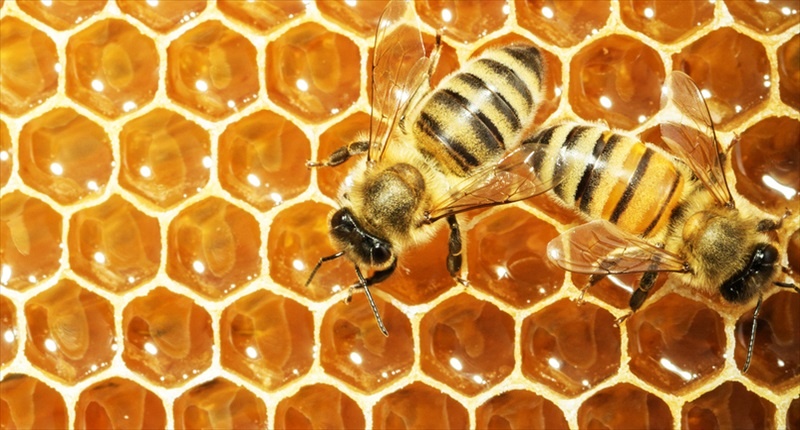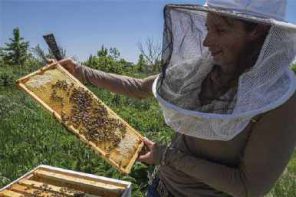by: Ross Conrad
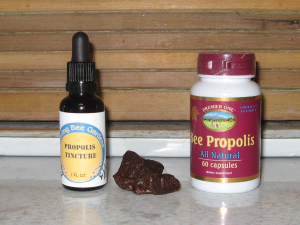
Propolis is available in several forms including raw (chunks), powdered (usually encapsulated or mixed with honey) and as a tincture.
The crisp cool Autumn weather arrives at a time when the color of the leaves change, mice build nests in well-protected warm places, and bees finish plugging up the cracks in their hives with propolis in anticipation of Winter.
The term propolis, (aka bee glue) originated with the Greeks who often observed a sticky resinous substance around the entrance to their hives. In Greek, “Pro” means coming before or in front of, and “Polis” is the Greek word for city or a body of citizens. Thus, propolis is what one could expect to find at the entrance to the city of the bees. Today beekeepers will often observe that the bees will use propolis to restrict or narrow the entrance to the hive to make it easier to defend. Honey bees use propolis as both a building material and as a way to sterilize and disinfect the cavity that contains the colony. This is because, as we will explore in this two part series, propolis is among the most powerful antimicrobial substances found in nature.
Honey bees make propolis out of the resins they collect from deciduous trees such as cottonwood, birch, alder and poplar (aspen). As these trees bud, they exude these resins around the bud in order to protect is from fungi and other diseses. Foraging bees utilize their pollen baskets (corbicula) to carry globs of propolis resins back to the hive. Unlike with pollen however, foragers require the help of other bees within the colony to help them remove the sticky resins from their hind legs so it may be used by the colony.
Composition
Over 240 compounds have been reported to have been extracted from honey bee propolis. While the composition of propolis will differ somewhat depending on which trees the bees gather the resins from, the typical composition tends to be approximately 45-55% resins, 25-35% waxes and fatty acids, 10% essential oils and aromatic compounds (phenolics), which includes vanillin and gives propolis the wonderful vanilla-like smell, and 5% pollen. An additional 5% or so of the constituents of propolis are other organic compounds such as flavonoids (or bioflavonoids collectively known as Vitamin P and citrin). There are even minor components of propolis that researchers have, to date, been unable to identify at all. When warm, propolis is as sticky as chewing gum, but it becomes hard and brittle when cold.
Production
Research indicates that conditions which stimulate the collection of propolis by a colony of bees include: rough surfaces within the hive, cracks and crevices within the hive that are smaller than the 5/16th of an inch bee space and not suitable for building comb, drafts and light coming into the hive in unwanted places, and disease infections.
Beekeeping supply companies often sell traps that can be used to collect propolis. The trap consists of a thin plastic sheet that has narrow slits cut into it and replaces the inner cover on the hive. Over time bees will fill the narrow slits in the plastic when the outer cover is flat on the hive, however, leaving the outer cover propped up to allow light and air in through the top of the hive will encourage the bees to plug up the holes in the propolis trap faster.
Once the trap is plugged up with propolis it is put in a bag and placed in a freezer for at least a few hours. Immediately upon removal from the freezer the trap (still inside the bag) is banged against a hard surface such as a table top, or simply contorted and gently bent back and forth in order to cause the brittle propolis to crack, break and fall from the trap.
Propolis can be collected by catching the hive scrapings when cleaning out the honey supers during the honey harvest as well. Unlike propolis collected from a trap, hive scrapings will tend to contain contaminants such as bits of wax, wood, dead bees, etc. One way these contaminants can be removed from the propolis by soaking the scrapings in a pail of water. Dead bees, pieces of wood and bees wax will tend to float while the propolis will tend to sink, allowing the beekeeper to separate out the majority of contaminants.
Another way to clean propolis hive scrapings is to place the propolis scrapings into an oven-proof container. The scrapings are covered with two to three inches of water and placed in an oven at 200°F. The contents of the container should be baked for at least two hours and stirred often in order to release any wax that may be trapped within the mass of propolis. The melted wax, pieces of wood, etc., will float to the surface of the water while the propolis will stick to the bottom of the container. After the container is removed from the oven and cooled, the waxy layer on the surface of the water can be removed and the water carefully poured off to reveal the colored propolis mass beneath it. The container of propolis can then be frozen and when the propolis is brittle, it can be chipped out of the container. The cleaned propolis pieces should be spread out on a sheet of paper or cardboard to dry before placing then into storage.
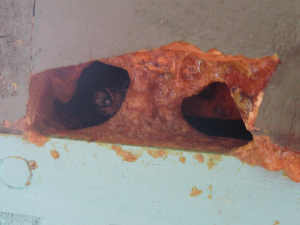
Honey bees may use propolis to reduce the size of the entrance to their hive making it easier to defend, and also to create a welcome mat that helps to sterilize the feet of all who enter.
As noted, honey bees use propolis as an extension of their immune system and rely upon it to keep healthy. I believe this is one of the primary reasons that when the genome mapping of the honey bee was conducted, it was found that bees have far fewer genes dedicated to immune response than any of the other insects that had also undergone genome mapping. The utilization of propolis by the colony appears to have eliminated the need for bees to invest biological energy in the development of a more robust immune system within the body of each bee. As a result, I don’t like to take propolis from my hives since doing so may decrease the overall health and vitality of the bees. However as we shall see, the profound health benefits that propolis can provide for humans compels me to collect propolis, but typically only from the honey supers that are being harvested in the honey house. Additionally, since I don’t want to do the extra work of cleaning it, I only collect and put aside chunks of pure propolis rather than try to capture all the propolis in the scrapings, etc. As a result, the amount of propolis I produce annually is rather small and results in only two-to-three dozen bottles of propolis alcohol tincture.
Processing
While propolis can be found in many products from toothpaste and skin creams to healing salves, herbal tinctures, syrups and elixirs, propolis does not require any processing (other than cleaning) in order for it to be used. For gum, dental, or sore throat issues simply tuck a chunk of raw propolis between the gum and cheek and suck on it. This is the simplest way to use it, although its benefits may be limited and it may stick to your teeth if you are not careful. Here are some of the more usual commercially available forms that pure processed propolis can be found in.
Powdered in capsule or tablet form
Before turning the propolis into powder, it must be cleaned such as described above. One way to turn chunks of propolis into powder is to freeze it for at least a few hours, along with a hand grinder or mortar and pestle. As soon as the propolis and grinder are removed from the freezer, the propolis should be ground up. A hand-powered grinder is preferable to an electric grinder since a hand grinder will not heat up as fast when in use, reducing the speed with which the propolis will become sticky and gum up the grinder.
While large companies may make tablets out of propolis, small producers may purchase capsules that can be used to encapsulate the powdered propolis. Alternatively, powdered propolis can be mixed with raw honey to make an especially tasty medicine. Since the propolis will tend to float to the top of liquid honey, it is best to use honey that is either naturally crystalized or in the process of crystalizing in order to capture and keep the propolis suspended in and throughout the honey.
Tinctures or Extracts
It is relatively easy to make propolis extracts or tinctures and they can be prepared with minimal time investment with only two ingredients: propolis and an appropriate solvent.
Choosing the correct solvent is very important, especially if the product is to be used for human consumption. For the highest quality extract, ethanol (also called grain alcohol, pure alcohol or ethyl alcohol C2H6O) is used, however any food grade alcohol that is at least 130 proof (65% alcohol) will work well.
Ideally propolis is ground into a powder prior to making a tincture or extract from it. This is done in order to maximize the surface area of the propolis for the solvent to work on. I have found however, that large unbroken chunks of propolis will dissolved when using grain alcohol to make tinctures, eliminating the work of grinding up the propolis beforehand.
To make the tincture, place the alcohol and propolis into a water-tight container, seal the top and shake briefly. Shaking should be repeated once or twice a day, and the mixture left soaking in the alcohol for one-to-two weeks for best results.
After a couple weeks, the extract is ready and may be filtered through a clean and very fine cloth, paper filter or cotton ball. The remains of the first filtration can be soaked in alcohol again for an additional extract, however it may not be quite as potent as the first extract.
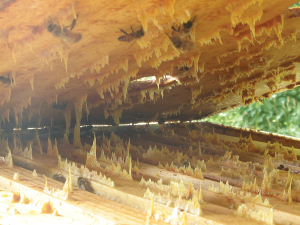 The finished tincture will be a clear liquid, free of particles and dark brown or slightly reddish in color. It is best bottled in clean, dark, airtight bottles for long-term storage. When a tincture with a high concentration of propolis is desired one can simply add more propolis and less solvent to the container and the filtering process can be eliminated. Rather than filter the resulting liquid, the extract is simply poured off allowing some of the fine particles that do not fully dissolve and collect in the bottom of the soaking container to be transferred into the final storage container. Additionally, the container of the final propolis tincture can be left out with a porous cover (such as cheese cloth) in order to allow some of the solvent to evaporate over time increasing the percentage of propolis in the final product and reducing the ethanol content.
The finished tincture will be a clear liquid, free of particles and dark brown or slightly reddish in color. It is best bottled in clean, dark, airtight bottles for long-term storage. When a tincture with a high concentration of propolis is desired one can simply add more propolis and less solvent to the container and the filtering process can be eliminated. Rather than filter the resulting liquid, the extract is simply poured off allowing some of the fine particles that do not fully dissolve and collect in the bottom of the soaking container to be transferred into the final storage container. Additionally, the container of the final propolis tincture can be left out with a porous cover (such as cheese cloth) in order to allow some of the solvent to evaporate over time increasing the percentage of propolis in the final product and reducing the ethanol content.
Denatured, rubbing or methyl alcohol should never be used if the final product is intended for internal human consumption since toxins are added to such alcohols in order to make them unpalatable and prevent ingestion. To be safe, the only time that rubbing alcohol may be used to produce a propolis tincture is when the resulting tincture is to be applied to beekeeping equipment in order to ‘pre-propolize’ it for honey bee use, as is done by some biodynamic beekeepers. However since there are different types of denatured alcohols intended for different purposes and the chemicals added to denature alcohol may be poisonous to bees, caution should be taken and such extracts should only be used to preserve the outside of the hive, reserving only extracts appropriate for human consumption for use on the inner surfaces of hive bodies and supers.
Aqueous (Water) or Hydrolyzed Propolis
For individuals that wish to avoid alcohol, a water extract may be desirable. Aqueous extracts can be obtained by soaking propolis in water or boiling it in water. When boiling, some of the propolis’ aromatic compounds may be lost however. Even though the yield of active and medicinal ingredients is generally lower than when making an alcohol tincture, water extracts have been shown to have powerful bactericidal and fungicidal effects. All other processing, filtering, etc. is the same as described above. Water extracts of propolis should be refrigerated in order to suppress the growth of mold.
Oil Extract
An oil extract of propolis may be obtained by filling a pot with propolis and any food grade oil (coconut, sunflower, olive, etc.) or even with butter. The contents of the pan are gently heated in a water bath and stirred constantly for about 10 minutes. The resulting extract can be filtered and stored in sealed containers in the dark.
Propolis extracts are also obtained by using other solvents such as vegetable glycerin or Propylene Glycol. Even though the alcohol process results in the most potent extract, it does not mean it will be the best for all uses and situations. For example, water extracts are preferred when treating eye infections since it is not advisable to put alcohol or oil in the eyes for obvious reasons. Oil extracts on the other hand are recommended for mouth and gum problems, and may be best for external use on people or babies with sensitive skin.
Next month we will explore the many medicinal benefits and uses of propolis for man and animals.
Ross Conrad is the author of Natural Beekeeping: Organic Approaches to Modern Apiculture, 2nd Edition.







